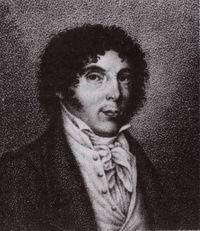
Domenico Cimarosa was an Italian composer of the Neapolitan School and of the Classical period. He wrote more than eighty operas, the best known of which is Il matrimonio segreto (1792); most of his operas are comedies. He also wrote instrumental works and church music.

Giuseppe Gazzaniga was a member of the Neapolitan school of opera composers. He composed fifty-one operas, particularly opera buffa.
Calandrino is a character from Giovanni Boccaccio's the Decameron, in which he appears in four stories. In these tales he is the victim of the pranks of Bruno and Buffalmacco. He becomes a recurring character in Renaissance literature, especially in Italy.

Luca Ronconi was an Italian actor, theatre director, and opera director.
The Salzburg Whitsun Festival, at times branded as Whitsun+Baroque or Salzburg Festival Whitsun, is a classical music and opera festival held every year in Salzburg, Austria over Pentecost (Whitsun) weekend in late May or early June. It takes place at the Salzburg Great Festival Theatre and the adjoining and smaller Haus für Mozart.

La finta parigina (The false Parisienne) is an opera buffa in 3 acts by Domenico Cimarosa with an Italian libretto by Francesco Cerlone. The opera premiered at the Teatro Nuovo in Naples, in 1773.

Le donne rivali is an intermezzo in two acts by composer Domenico Cimarosa with an Italian libretto by a now unknown poet. It is speculated that Giuseppe Petrosellini may have been the author of the libretto. The opera premiered at the Teatro Valle in Rome during Carnival in 1780. The original choreography was created by Alberto Cavos, the original costumes by Antonio Dian, and the original scenery by Domenico Fossati. In accordance with Papal law on theatre in Rome, the premiere cast was all-male.
Irina Iordachescu is a Romanian soprano opera singer.

Stefano Pavesi was an Italian composer. He is primarily known as a prolific opera composer; his breakthrough opera was Fingallo e Comala, and his acknowledged opera masterpiece is Ser Marcantonio. He also served as the maestro di cappella of Crema Cathedral from 1814 to 1818, and alone from 1818 until his death at the age of 71.
Luigi Mosca was Italian composer of operas and sacred music and a noted singing teacher. He composed eighteen operas, most of which were originally for theatres in Naples, but played throughout Italy in their day.

L'Italiana in Londra is one of eight comic operas, termed intermezzi, which Domenico Cimarosa wrote between 1777 and 1784 for the Teatro Valle, a handsome neo-classical Roman theatre built in 1726, which still stands today.

Juan Francisco Gatell is an Argentinian operatic tenor who specialises in the bel canto repertoire.

Teatro San Ferdinando is a theatre in Naples, Italy. It is named after King Ferdinand I of Naples. Located near Ponte Nuovo, it is to the southeast of the Teatro Totò in the western part of the neighborhood of Arenaccia. Built in the late eighteenth century, the seats are arranged in four box tiers, and the pit. It is most associated with Eduardo De Filippo and the productions of the 1950s under his direction. Closed in the 1980s and reopened in 2007, the San Fernando is managed by the Teatro Stabile of Naples.
Giuseppe Petrosellini was an Italian poet and prolific librettist working primarily in the dramma giocoso and opera buffa genres.
Laura Giordano is an Italian lyric soprano.

The Teatro Nuovo is a theatre located on Via Montecalvario in the Quartieri Spagnoli district of Naples. The original theatre was an opera house designed by Domenico Antonio Vaccaro. Completed in 1724, it was also known as the Teatro Nuovo sopra Toledo and the Teatro Nuovo de Montecalvario. The theatre specialised in the opera buffa genre and saw the world premieres of hundreds of operas in its heyday. These included fifteen of Cimarosa's operas and seven of Donizetti's. The present theatre is the third to have been erected on the site following its destruction by fire in 1861 and again in 1935.

Giunio Bruto is a two-act opera seria in two acts by Domenico Cimarosa to a libretto by Eschilo Acanzio, composed in 1781.
Artemisia is the last opera of Domenico Cimarosa. The libretto, in three acts, is by Count Giovanni Battista Colloredo. Cimarosa died on 11 January 1801 before writing the music to Act III; the first performance, given at the Teatro La Fenice in Venice on 17 January 1801, also included interpolations by other hands in the first two acts.
Mario Cassi is an Italian baritone.

Elena Tsallagova is a Russian operatic soprano who has performed at major opera houses and festivals in Europe. She was noticed internationally as Nanetta in Verdi's Falstaff at the Glyndebourne Festival, and in the title role of Janáček's The Cunning Little Vixen at the Paris Opera. She has been a member of Deutsche Oper Berlin since 2013, performing lead roles such as Debussy's Mélisande, Gilda in Verdi's Rigoletto and Sophie in Der Rosenkavalier by Richard Strauss.











